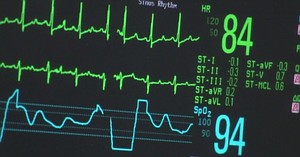7/10/2017

By Michael Nedelman
CNN
(CNN) -- When Dr. Joseph Schlesinger's mother was in the hospital, it was hard to speak with her by phone above the beeps and blips of medical devices. It was even harder for her to get some shut-eye.
"She couldn't sleep at all," said Schlesinger, an assistant professor of anesthesiology at Vanderbilt University Medical Center. "In fact, it was very disorienting for her in the hospital."
A noisy hospital -- not to mention interruptions by doctors and nurses and light exposure -- can make it difficult to rest when people need it most, according to researchers. And the result of a noisy hospital isn't just a groggy patient; it can also negatively affect your health, experts warn.
"Hospitals can be as loud as 72 decibels. That's like trying to talk to somebody standing next to a vacuum cleaner," Schlesinger said.
The World Health Organization recommends that hospital noise not exceed 30 decibels at night and 35 decibels during the day. A 2005 study at Johns Hopkins found no location in the hospital to be in compliance with WHO standards; average sound levels were in the 50 to 60 decibel range. Some parts of the hospital peaked much higher.
Schlesinger has his sights set on cutting out some of the noise and getting his patients to sleep. In Vanderbilt's three-story echo-proof sound chamber, he's testing medical device sounds that are easier on the ears. In the chamber, a ring of speakers surrounds a single chair, testing a variety of sounds from different angles. The sounds, he said, should be "alerting ... not jarring."
But Schlesinger is also taking the reverse approach: preventing patients from hearing the device alarms that are already there. He is developing an earbud that can do just that.
"What I wanted to do was take the alarms out of the environment for the patient," he said. "They don't need to hear them, and I want them to sleep."
Schlesinger presented the pilot device last month at the International Conference on Auditory Display: a small black box connected to a microphone, a pair of headphones and a keyboard to input commands. Because medical devices often have narrow, high-pitched frequencies, a basic filter can clip out those noises without distorting other sounds, like human speech. Schlesinger said he is working with engineers to develop a standalone prototype that would be in-ear and have no delay.
Schlesinger said it's important that the device not muffle or distort other sounds, which can be disorienting for the patient. This is why simple earplugs may not always be the best choice, he added.
Products like Here One earbuds have similar technology, but Schlesinger hopes that his prototype will be better-suited for the health-care environment.
"At first glance, I am excited about this, and I do think it's innovative," said Erica Ryherd, associate professor of architectural engineering at the University of Nebraska, Lincoln who specializes in health-care design. Ryherd is not involved in Schlesinger's project.
More research will need to be done on how well the earbuds work, how patients respond to them and how comfortable they are to wear long-term, Ryherd added.
"My concern is that we just don't forget about the other things that are problematic," she said.
An earbud, she said, wouldn't change the source of the sound or how hospitals are designed. For example, hospitals often have hard, resonant floors that echo and propagate noise. To combat this, some have incorporated new materials into walls and ceiling tiles that can dampen sound but that are still hygienic and cleanable, Ryherd said.
"Hospitals do seem to be getting noisier as time goes on," she added, but alarms are hardly the only noise around. Between the bustle of people, carts rolling down the hallway and even the occasional helicopter, there's a lot going on in a dense space.
But medical devices do have certain acoustic features -- like their pitch, loudness and repetitiveness, she said -- that make them stand out from the din in order to alert doctors and nurses when something is amiss.
Louder noise in the hospital may have led to an arms race of even louder alarms, all clamoring to be heard over each other. Some researchers call this an "acoustic feedback loop."
The problem, Schelesinger said, is that many alarms are useless.
In one study of a single intensive care unit, for example, only 15% of alarms were considered "clinically relevant." About 40% were just plain wrong. Some of these noises only end up alarming the patients, Schlesinger said; doctors may know which noises require them to spring into action, but patients may think they're being ignored.
The end result, Schlesinger said, is that noisy, restless nights in the hospital can be disorienting for patients. This may especially be the case in the intensive care unit (ICU), where some of the most serious patients are monitored but which also happens to be one of the louder places in the hospital, he said.
Research has linked poor sleep with delirium in the ICU, higher blood pressure and worse mental health outcomes. It may also increase sensitivity to pain.
The federal Centers for Medicare and Medicaid Services asks about nighttime quietness on its patient satisfaction survey. This may give hospitals a financial incentive to turn down the volume, as survey scores are tied to reimbursements.
"You can't take away patient monitoring -- that's critical -- but it's not really working for the patients," Ryherd said. "I can't think of too many people I've talked to that have enjoyed the sound environment of the hospital."
